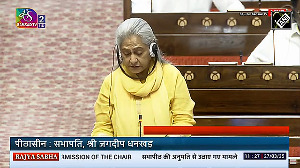Y Gopala Rao who retired as chairman and managing director, Bharat Electronics, a defence PSU based out of Bangalore, had identified cutting costs as a key objective for the future.
His logic is simple: "Our mantra is 'cost reduction for survival'. If you want to get Rs 10 crore (Rs 10 million) improvement in your bottomline, you need to sell Rs 100 crore (Rs 1 billion). This means Rs 100 crore of orders, material procurement and manufacturing. But if you save Rs 10 crore, it will straightway add to the bottomline."
The company had created a special task force to drive cost reduction at its nine manufacturing units across the country. But the cost reduction practices do not compromise on quality, says Rao.
A few years down the line, BEL intends to be much slimmer, without compromising its core strength -- design engineering. From an organisation of about 18,000 people 10 years ago, the company is down to about 12,000 and plans to further downsize to 10,000 in the next 4-5 years. "Our idea is to enhance our core strength, design ability and outsource manufacturing to the extent possible," adds Rao.
The most important parameter is value-addition. The value-addition per employee has now gone up from a few lakhs to Rs 12.5 lakh last fiscal. "This is much higher than other PSUs and it has been constantly improving," said Rao.
Ten years ago, the number of engineers was 2,300. Presently, it is 2,900. "A lot of manual work that used to be done by us earlier is taking a backseat as future products, being design-centric, would have less labour content. About 35 per cent of our total engineers strength is deployed in R&D," said Rao.
BEL, Rao says, has found ways to address attrition. Three years ago, when the IT boom was on, BEL had almost 250 people quitting every year. Now this is in the range of 75-80.
The company is recruiting on an average about 300 people every year, to compensate the loss. Besides, the company is going in for campus recruitments. Campus recruitment is up from 30 per cent to 50 per cent.
"We are focusing on regional engineering colleges in and around the places where our factories are located. This helps us recruit more and more local people, who can stay in the company for a longer period," said Rao.
The Rs 10,000 crore revenue target, the company aims to achieve in the next five years is not difficult to achieve. "The target is within our reach since we have doubled our revenues to Rs 3,561 crore in FY05-06 in less than 4-5 years. So, we are quite confident of achieving this, in the next five years, by leveraging our R&D strengths and entering more segments in the civilian market," he says.
BEL spends about 4-5 per cent of its revenues on R&D and aims to rely more and more on its own designs rather than technology transfer. In FY05-06, 73 per cent of its revenues had come from the products manufactured based on indigenous design and development. In FY06-07, the company targets to take the contribution of its own R&D based revenue to 75 per cent from the current year's 73 per cent.
Going forward, the civilian market will be a growth driver for the company, apart from the defence sector. Some of the company's civilian products have made their mark. While the vacuum interrupter tubes, being manufactured by the company, have already got acceptance among the switch gear manufacturers in the country, the photovoltaic systems manufactured by BEL are used extensively at traffic signals.
The company has also started large shipments of its set-top boxes for direct-to-home (DTH) telecast and conditional access system (CAS). Recently, the company got an order for 200,000 units of set top boxes for CAS from Wires and Wirelsss, a Zee Group company.
Besides, BEL expects some breakthrough in the export of its electronic voting machines (EVMs), a patented product.
"Countries like Nigeria, Mauritius and Sri Lanka have shown interest in the EVMs. Since the election process in those countries are different from ours, we have to customise the machines to their needs," he said.







 © 2025
© 2025